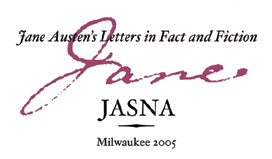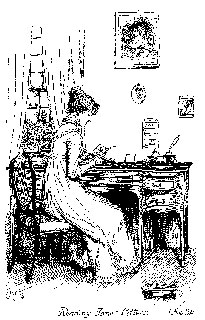 Jane Austen Society of North America 2005 Annual General Meeting October 7-9, 2005 Hyatt Regency Hotel, Milwaukee, Wisconsin Conference Theme The
theme of the 2005 AGM,
“Jane Austen’s Letters in Fact and Fiction,” encompasses two
fascinating topics. The conference will examine the most significant
primary source material in existence concerning Austen’s life and
work—her own correspondence. And, for members who feel that no AGM is
complete without a focus on the novels, the program will also look at
Austen’s use of letters in her fiction and her place in epistolary
literature.
Letters in Fact I
have now attained the true
art of letter-writing, which we are always told, is to express on paper
exactly what one would say to the same person by word of mouth; I have
been talking to you almost as fast as I could the whole of this
letter.
 —Jane
to Cassandra, January 3, 1801
The
1995 publication of the
definitive edition of Jane Austen’s
Letters (Oxford
University Press), edited by Deirdre Le Faye, has led to a renewed
interest in Austen’s correspondence. Read in conjunction with Le Faye’s
notes, the letters represent both autobiography and sparkling
entertainment, written with the wry humor and narrative voice found in
the novels. They provide insight into Austen’s personality, writing
techniques, and relationships. This will be one of the few JASNA
conferences offering a forum on Austen herself—sister, daughter, and
friend, as well as author.
Letters in Fiction What do you think of my wife’s style of letter-writing?—delicate—tender—truly feminine—was it not? —Willoughby
to Elinor Dashwood, Sense and
Sensibility
 The program will also examine
Austen’s prolific use of letters in her fiction—from Lady Susan, told entirely in
letters, through Persuasion,
whose ending Austen revised to include Capt. Wentworth’s soul-piercing
letter to Anne Elliot. Courtship and proposals proceed by means of
letters; plots are twisted, fates determined, and characters
assassinated and rehabilitated in correspondence. The program will also examine
Austen’s prolific use of letters in her fiction—from Lady Susan, told entirely in
letters, through Persuasion,
whose ending Austen revised to include Capt. Wentworth’s soul-piercing
letter to Anne Elliot. Courtship and proposals proceed by means of
letters; plots are twisted, fates determined, and characters
assassinated and rehabilitated in correspondence. Sense and Sensibility and Pride and Prejudice probably both began as epistolary novels, in the 18th century tradition. When, as a mature writer, Austen revised them for publication, she rejected the old form and created instead a tight narrative structure that makes strategic use of letters without relying exclusively on them to tell the story. The AGM’s focus on letters in Austen’s fiction will provide a deeper understanding of her art and the innovations she introduced in the English novel.
|